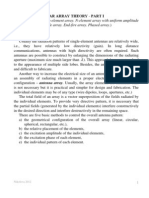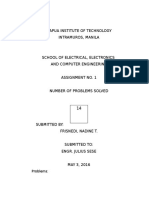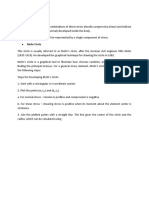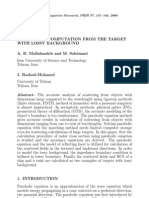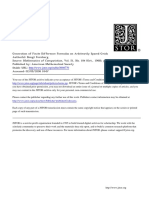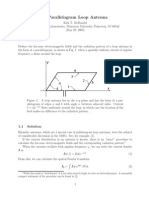Lecture 16: Planar Arrays and Circular Arrays 1. Planar Arrays
Lecture 16: Planar Arrays and Circular Arrays 1. Planar Arrays
Uploaded by
Usuario TipoCopyright:
Available Formats
Lecture 16: Planar Arrays and Circular Arrays 1. Planar Arrays
Lecture 16: Planar Arrays and Circular Arrays 1. Planar Arrays
Uploaded by
Usuario TipoOriginal Title
Copyright
Available Formats
Share this document
Did you find this document useful?
Is this content inappropriate?
Copyright:
Available Formats
Lecture 16: Planar Arrays and Circular Arrays 1. Planar Arrays
Lecture 16: Planar Arrays and Circular Arrays 1. Planar Arrays
Uploaded by
Usuario TipoCopyright:
Available Formats
Nikolova 2010
1
LECTURE 16: PLANAR ARRAYS AND CIRCULAR ARRAYS
1. Planar arrays
Planar arrays provide directional beams, symmetrical patterns with low side
lobes, much higher directivity (narrow main beam) than that of their individual
element. In principle, they can point the main beam toward any direction.
Applications tracking radars, remote sensing, communications, etc.
The array factor of a rectangular planar array
Fig. 6.23b, p. 310, Balanis
Nikolova 2010
2
The AF of a linear array of M elements along the x-axis is
( )( ) 1 sin cos
1 1
1
x x
M
j m kd
x m
m
AF I e
u | | +
=
=
(16.1)
where sin cos cos
x
u | = is the directional cosine with respect to the x-axis (
x
is the angle between r and the x axis). It is assumed that all elements are
equispaced with an interval of
x
d and a progressive shift
x
| .
1 m
I denotes the
excitation amplitude of the element at the point with coordinates: ( 1)
x
x m d = ,
0 y = . In the figure above, this is the element of the m-th row and the 1
st
column of the array matrix.
If N such arrays are placed at even intervals along the y direction, a
rectangular array is formed. We assume again that they are equispaced at a
distance
y
d and there is a progressive phase shift
y
| along each row. We also
assume that the normalized current distribution along each of the x-directed
arrays is the same but the absolute values correspond to a factor of
1n
I
( 1,..., ) n N = . Then, the AF of the entire MN array is
( )( ) ( )( )
1 sin sin 1 sin cos
1 1
1 1
y y x x
N M
j n kd j m kd
n m
n m
AF I I e e
u | | u | | + +
= =
(
=
(
, (16.2)
or
M N
x y
AF S S = , (16.3)
where
( )( ) 1 sin cos
1 1
1
x x
M
M
j m kd
x x m
m
S AF I e
u | | +
=
= =
, and
( )( )
1 sin sin
1 1
1
y y
N
N
j n kd
y y n
n
S AF I e
u | | +
=
= =
.
In the array factors above,
sin cos cos ,
sin sin cos .
x
y
u |
u |
= =
= =
x r
y r
(16.4)
The pattern of a rectangular array is the product of the array factors of the linear
arrays in the x and y directions.
Nikolova 2010
3
In the case of a uniform planar (rectangular) array,
1 1 0 m n
I I I = = for all m
and n, i.e., all elements have the same excitation amplitudes. Thus,
( )( ) ( )( )
1 sin sin 1 sin cos
0
1 1
y y x x
M N
j n kd j m kd
m n
AF I e e
u | | u | | + +
= =
=
. (16.5)
The normalized array factor is obtained as
sin sin
1 1 2 2
( , )
sin sin
2 2
y
x
n
x y
N M
AF
M N
u |
(
| | (
| |
| | (
(
\ . \ .
(
( =
| | | | (
(
|
|
(
(
\ .
\ .
, (16.6)
where
sin cos ,
sin sin .
x x x
y y y
kd
kd
u | |
u | |
= +
= +
The major lobe (principal maximum) and grating lobes of the terms
sin
1 2
sin
2
M
x
x
x
M
S
M
| |
|
\ .
=
| |
|
\ .
(16.7)
and
sin
1 2
sin
2
N
y
y
y
N
S
N
| |
|
\ .
=
| |
|
\ .
(16.8)
are located at angles such that
sin cos 2 , 0,1,
x m m x
kd m m u | | t + = = ! (16.9)
sin sin 2 , 0,1,
y n n y
kd n n u | | t + = = ! (16.10)
The principal maximum corresponds to 0 m = , 0 n = .
Nikolova 2010
4
In general,
x
| and
y
| are independent from each other. But, if it is required
that the main beams of
M
x
S and
N
y
S intersect (which is usually the case), then
the common main beam is in the direction:
0
u u = and
0
| | = , 0 m n = = . (16.11)
If the principal maximum is specified by
0 0
( , ) u | , then the progressive phases
x
| and
y
| must satisfy
0 0
sin cos
x x
kd | u | = , (16.12)
0 0
sin sin
y y
kd | u | = . (16.13)
When
x
| and
y
| are specified, the direction of the main beam can be found by
simultaneously solving (16.12) and (16.13):
0
tan
y x
x y
d
d
|
|
|
= , (16.14)
2
2
0
sin
y x
x y
kd kd
| |
u
| |
| |
= +
|
|
\ .
\ .
. (16.15)
The grating lobes can be located by substituting (16.12) and (16.13) in (16.9)
and (16.10):
0 0
0 0
sin sin
tan
sin cos
y
mn
x
n
d
m
d
u |
|
u |
, (16.16)
0 0
0 0
sin sin
sin cos
sin
cos sin
y
x
mn
mn mn
n
m
d
d
u |
u |
u
| |
= = . (16.17)
To avoid grating lobes, the spacing between the elements must be less than
(
y
d < and
y
d < ). In order a true grating lobe to occur, both equations
(16.16) and (16.17) must have a real solution ( , )
mn mn
u | .
The array factors of a 5 by 5 uniform array are shown below for two
spacings, / 4 d = and / 2 d = . Notice the considerable decrease in the
beamwidth as the spacing is increased from / 4 to / 2 .
Nikolova 2010
5
DIRECTIVITY PATTERNS OF A 5-ELEMENT SQUARE PLANAR UNIFORM ARRAY
WITHOUT GRATING LOBES 0
x y
| | = = : (a) / 4 d = , (b) / 2 d =
0
10.0287 (10.0125 dB) D =
0
33.2458 (15.2174 dB) D =
(a) (b)
Nikolova 2010
6
The beamwidth of a planar array
x
y
z
h
|
h
u
0
u
0
|
h
|
A simple procedure, proposed by R.S. Elliot
1
is outlined below. It is based
on the use of the beamwidths of the linear arrays building the planar array.
For a large array, whose maximum is near the broad side, the elevation
plane HPBW is approximately
( )
2 2 2 2 2
0 0 0
1
cos cos sin
h
x y
u
u u | u |
=
A + A
(16.18)
where
1
Beamwidth and directivity of large scanning arrays, The Microwave Journal, Jan. 1964, pp.74-82.
Nikolova 2010
7
0 0
( , ) u | specifies the main-beam direction;
x
u A is the HPBW of a linear broadside array whose number of
elements M and amplitude distribution is the same as that of
the x-axis linear arrays building the planar array;
y
u A is the HPBW of a linear BSA whose number of elements N
and amplitude distribution is the same as those of the y-axis
linear arrays building the planar array.
The HPBW in the plane, which is orthogonal to the
0
| | = plane and
contains the maximum, is
2 2 2 2
0 0
1
sin cos
h
x y
|
u | u |
=
A + A
. (16.19)
For a square array ( ) M N = with amplitude distributions of the same type
along the x and y axes, equations (16.18) and (16.19) reduce to
0 0
cos cos
y x
h
u u
u
u u
A A
= = , (16.20)
h x y
| u u = A = A . (16.21)
From (16.20), it is obvious that the HPBW in the elevation plane very much
depends on the elevation angle
0
u of the main beam. The HPBW in the
azimuthal plane
h
| does not depend on the elevation angle
0
u .
The beam solid angle of the planar array can be approximated by
A h h
u | O = , (16.22)
or
2 2
2 2 2 2 2
0 0 0 0 0
2 2
cos sin cos sin cos
x y
A
y x
x y
u u
u u
u | | | |
u u
A A
O =
(
A ( A
+ +
(
(
A A
. (16.23)
Nikolova 2010
8
Directivity of planar rectangular array
The general expression for the calculation of the directivity of an array is
2
0 0
0
2
2
0 0
| ( , ) |
4
| ( , ) | sin
AF
D
AF d d
t t
u |
t
u | u u |
=
} }
. (16.24)
For large planar arrays, which are nearly broadside, (16.24) reduces to
0 0
cos
x y
D D D t u = (16.25)
where
x
D is the directivity of the respective linear BSA, x-axis;
y
D is the directivity of the respective linear BSA, y-axis.
We can also use the array solid beam angle
A
O in (16.23) to calculate the
approximate directivity of a nearly broadside planar array:
2
0
[Sr]
[deg ]
4 32400
A
A
D
t
=
O O
. (16.26)
Remember:
1) The main beam direction is controlled through the phase shifts,
x
| and
y
| .
2) The beamwidth and side-lobe levels are controlled through the amplitude
distribution.
Nikolova 2010
9
2. Circular array
Nikolova 2010
10
Array factor of circular array
The normalized field can be written as
1
( , , )
n
N
jkR
n
n
n
e
E r a
R
u |
=
=
, (16.27)
where
2 2
2 cos
n n
R r a ar = + . (16.28)
For r a , (16.28) reduces to
cos ( )
n
n n
R r a r a
a r . (16.29)
In a rectangular coordinate system,
cos sin
sin cos sin sin cos
n
n n
| |
u | u | u
= +
= + +
a x y
r x y z
Therefore,
( )
sin cos cos sin sin
n n n
R r a u | | | | + , (16.30)
or
( )
sin cos
n n
R r a u | | . (16.31)
For the amplitude term, the approximation
1 1
, all
n
n
R r
(16.32)
is made.
Assuming the approximations (16.31) and (16.32) are valid, the far-zone
array field is reduced to
sin cos( )
1
( , , )
n
N
jkr
jka
n
n
e
E r a e
r
u | |
u |
=
=
, (16.33)
where
n
a is the complex excitation coefficient (amplitude and phase);
2 /
n
n N | t = is the angular position of the n-th element.
Nikolova 2010
11
In general, the excitation coefficient can be represented as
n
j
n n
a I e
o
= , (16.34)
where
n
I is the amplitude term, and
n
o is the phase of the excitation of the n-th
element relative to a chosen array element of zero phase,
( )
( ) sin cos
1
, ,
n n
N
jkr
j ka
n
n
e
E r I e
r
u | | o
u |
+ (
=
=
. (16.35)
The AF is obtained as
( ) sin cos
1
( , )
n n
N
j ka
n
n
AF I e
u | | o
u |
+ (
=
=
. (16.36)
Expression (16.36) represents the AF of a circular array of N equispaced
elements. The maximum of the AF occurs when all the phase terms in (16.36)
equal unity, or,
( )
sin cos 2 , 0, 1, 2, all
n n
ka m m n u | | o t + = = . (16.37)
The principal maximum ( 0 m = ) is defined by the direction
0 0
( , ) u | , for which
( )
0 0
sin cos , 1, 2,...,
n n
ka n N o u | | = = . (16.38)
If a circular array is required to have maximum radiation in the direction
0 0
( , ) u | , then the phases of its excitations have to fulfil (16.38). The AF of such
an array is
| | 0 0
sin cos( ) sin cos( )
1
( , )
n n
N
jka
n
n
AF I e
u | | u | |
u |
=
=
, (16.39)
0
(cos cos )
1
( , )
n n
N
jka
n
n
AF I e
u |
=
=
. (16.40)
Here,
| |
arccos sin cos( )
n n
u | | = is the angle between
r and
n
a ;
| |
0 0 0
arccos sin cos( )
n
n
u | | = is the angle between
n
a and
max
r
pointing in the direction of maximum radiation.
Nikolova 2010
12
As the radius of the array a becomes large compared to , the directivity of
the uniform circular array (
0
, all
n
I I n = ) approaches the value of N.
UNIFORM CIRCULAR ARRAY 3-D PATTERN (N=10, 2 / 10 ka a t = = ):
MAXIMUM AT 0 ,180 u =
0
11.6881 (10.6775 dB) D =
Nikolova 2010
13
UNIFORM CIRCULAR ARRAY 3-D PATTERN (N=10, 2 / 10 ka a t = = ):
MAXIMUM AT 90 , 0 u | = =
0
10.589 (10.2485 dB) D =
You might also like
- Maths Formula Sheet of Icse StudentsDocument13 pagesMaths Formula Sheet of Icse Studentsvidhiseth88% (111)
- Iec 60529Document9 pagesIec 60529wawan100% (1)
- Aci318 14Document74 pagesAci318 14Vinicio Cola55% (11)
- Lectura 18 - Planar ArraysDocument13 pagesLectura 18 - Planar Arrayscnk3ajl+6vy288No ratings yet
- Lecture37 PDFDocument3 pagesLecture37 PDFAnkan GayenNo ratings yet
- Pot 078Document7 pagesPot 078Zafer ÜnalNo ratings yet
- Broadside and Endfire Array AntennasDocument21 pagesBroadside and Endfire Array AntennasSrinivas ReddyNo ratings yet
- PalermoDocument4 pagesPalermoRajni GulatiNo ratings yet
- Multi-Mass Spring ModelingDocument5 pagesMulti-Mass Spring ModelingJohn AlexiouNo ratings yet
- Lecture Notes - Antenna ArraysDocument35 pagesLecture Notes - Antenna ArraysAhmed AlbidhanyNo ratings yet
- Volume 3 No. 2 Pp. 67-101 (2010) C IejgDocument35 pagesVolume 3 No. 2 Pp. 67-101 (2010) C Iejgnanda anastasyaNo ratings yet
- Differentiable ManifoldDocument73 pagesDifferentiable ManifoldKirti Deo MishraNo ratings yet
- hw1 ElemagDocument15 pageshw1 ElemagNadine FrisnediNo ratings yet
- Representation and Modeling of Spherical Harmonics Manifold For Source LocalizationDocument5 pagesRepresentation and Modeling of Spherical Harmonics Manifold For Source LocalizationLalanKumarNo ratings yet
- Application of The Chebyshev Polynomials To Approximation and Construction of Map ProjectionsDocument10 pagesApplication of The Chebyshev Polynomials To Approximation and Construction of Map ProjectionsEdinson Figueroa FernandezNo ratings yet
- L16 Arrays4Document13 pagesL16 Arrays4sonikachoudhary393No ratings yet
- Solving Poisson's Equation by Finite DifferencesDocument6 pagesSolving Poisson's Equation by Finite DifferencesEugene LiNo ratings yet
- Lapde Unit V MCQ'SDocument5 pagesLapde Unit V MCQ'SJayashreeNo ratings yet
- Maths QBDocument1 pageMaths QBAthang MalgundkarNo ratings yet
- Fresnel's Equations For Reflection and Transmission: Incident, Transmitted, and Reflected BeamsDocument22 pagesFresnel's Equations For Reflection and Transmission: Incident, Transmitted, and Reflected BeamsJeffrey PhelpsNo ratings yet
- Fresnel's Equations For Reflection and Refraction: Incident, Transmitted, and Reflected BeamsDocument19 pagesFresnel's Equations For Reflection and Refraction: Incident, Transmitted, and Reflected Beamsgeraldin_rosa5078No ratings yet
- Hamel' S Theorem: A. W. MarrisDocument21 pagesHamel' S Theorem: A. W. MarrisDante FreidzonNo ratings yet
- Analysis of Cascaded Frequency Selective Surfaces With Dual Band ResponseDocument4 pagesAnalysis of Cascaded Frequency Selective Surfaces With Dual Band ResponseLibi RiyazNo ratings yet
- A New Approach For Magnetic Curves in Riemannian ManifoldsDocument15 pagesA New Approach For Magnetic Curves in Riemannian ManifoldsmarkrichardmuradNo ratings yet
- Circular Footing On A Semi-Infinite Elastic MediumDocument10 pagesCircular Footing On A Semi-Infinite Elastic MediumGuido AndreottiNo ratings yet
- Combined Stresses 1Document19 pagesCombined Stresses 1Mae Belle AngayNo ratings yet
- Electromagnetic (E-M) Theory of Waves at A Dielectric InterfaceDocument24 pagesElectromagnetic (E-M) Theory of Waves at A Dielectric InterfaceRuth SilvaNo ratings yet
- Nonholonomic Antenna: 1 Laws of Regular ReflectionDocument6 pagesNonholonomic Antenna: 1 Laws of Regular Reflectionfmunteanu_5No ratings yet
- EigenvaluesDocument6 pagesEigenvaluesAnonymous 7oXNA46xiNNo ratings yet
- Kawai 1999Document11 pagesKawai 1999rares mirveaNo ratings yet
- And Spacing. Broad-Side Array. End-Fire Array. Phased Array.)Document21 pagesAnd Spacing. Broad-Side Array. End-Fire Array. Phased Array.)Rahul AsNo ratings yet
- ESE PaperDocument13 pagesESE PaperNikhil GaidhaneNo ratings yet
- Dangla1988 APlaneStrainSoilStructureInteractionModelDocument14 pagesDangla1988 APlaneStrainSoilStructureInteractionModelpatrick danglaNo ratings yet
- Module 4Document15 pagesModule 4Vinu RamadhasNo ratings yet
- Shaped Beams From Thick Arrays: B. Sadasiva Rao and Dr. G.S.N. RajuDocument16 pagesShaped Beams From Thick Arrays: B. Sadasiva Rao and Dr. G.S.N. Rajuganga_chNo ratings yet
- Solid Angle DependencyDocument6 pagesSolid Angle DependencyHayden TornabeneNo ratings yet
- Scattering Computation From The Target With Lossy BackgroundDocument13 pagesScattering Computation From The Target With Lossy BackgroundnvanthaoNo ratings yet
- Mock Physics 2023Document8 pagesMock Physics 2023fopatseutchouaNo ratings yet
- 8 Improper IntegralsDocument63 pages8 Improper IntegralsAdameLastfiddlerNo ratings yet
- Effective Numerical Treatment of Boundary Integral Equations. J.C Lachat and WatsonDocument15 pagesEffective Numerical Treatment of Boundary Integral Equations. J.C Lachat and Watsonrahim.sihadjmohandNo ratings yet
- 3 - G Optics 3Document23 pages3 - G Optics 3Beauponte Pouky MezonlinNo ratings yet
- MCT Module 2Document68 pagesMCT Module 2Anish BennyNo ratings yet
- 06b) Plane Wave Spectrum - 1 - 28Document8 pages06b) Plane Wave Spectrum - 1 - 28Josh GreerNo ratings yet
- Magnetic Optics For Charged Particles: Ying K. WuDocument24 pagesMagnetic Optics For Charged Particles: Ying K. WussuresuNo ratings yet
- An Application of A Matrix Inequality in Quantum Information TheoryDocument8 pagesAn Application of A Matrix Inequality in Quantum Information TheorygejikeijiNo ratings yet
- Notes On Point Set Topology, Fall 2010: Stephan Stolz September 3, 2010Document11 pagesNotes On Point Set Topology, Fall 2010: Stephan Stolz September 3, 2010tbrackman99No ratings yet
- Spinor Darboux Equations of Curves in Euclidean 3-SpaceDocument7 pagesSpinor Darboux Equations of Curves in Euclidean 3-SpaceDon HassNo ratings yet
- FornbergDocument9 pagesFornbergSomya kumar SinghNo ratings yet
- Application of The Ritz Method To The Analysis of Non-Linear Free Vibrations of BeamsDocument12 pagesApplication of The Ritz Method To The Analysis of Non-Linear Free Vibrations of BeamsKuldeep BhattacharjeeNo ratings yet
- Exercises: Waves in SpaceDocument3 pagesExercises: Waves in SpaceKazaValiShaikNo ratings yet
- Von Mises DistributionDocument11 pagesVon Mises DistributionDenny PaatNo ratings yet
- On Contact Slant Submanifolds in Kenmotsu Space Forms: Pradeep Kumar PandeyDocument4 pagesOn Contact Slant Submanifolds in Kenmotsu Space Forms: Pradeep Kumar PandeyIOSRJEN : hard copy, certificates, Call for Papers 2013, publishing of journalNo ratings yet
- Loop AntennaDocument8 pagesLoop AntennaMahima ArrawatiaNo ratings yet
- Art CMJ (22oct2010)Document10 pagesArt CMJ (22oct2010)Henry CastilloNo ratings yet
- Scalar and Vector QuantitiesDocument6 pagesScalar and Vector QuantitiesBakare MayowaNo ratings yet
- Lectia I - AlgebraDocument12 pagesLectia I - AlgebraPirvulescu RamonaNo ratings yet
- Results in Physis, 1, (2011), 13-16Document12 pagesResults in Physis, 1, (2011), 13-16Cong Tuan Son VanNo ratings yet
- Exact Solutions For The Modified KDV and The Generalized KDV Equations Via Exp-Function MethodDocument21 pagesExact Solutions For The Modified KDV and The Generalized KDV Equations Via Exp-Function MethodAnonymous 9U8UN35CalNo ratings yet
- Hy Using A New Statistically Optimal (N975) Patch Near-Field Acoustical Holograp MethodDocument8 pagesHy Using A New Statistically Optimal (N975) Patch Near-Field Acoustical Holograp MethodWon-young SeoNo ratings yet
- Review Exam MATH Questions and AnswersDocument73 pagesReview Exam MATH Questions and AnswersheelchristianNo ratings yet
- Harmonic Maps and Minimal Immersions with Symmetries (AM-130), Volume 130: Methods of Ordinary Differential Equations Applied to Elliptic Variational Problems. (AM-130)From EverandHarmonic Maps and Minimal Immersions with Symmetries (AM-130), Volume 130: Methods of Ordinary Differential Equations Applied to Elliptic Variational Problems. (AM-130)No ratings yet
- Guideline Replacing WMPT With UMPTDocument5 pagesGuideline Replacing WMPT With UMPTDani FirmanNo ratings yet
- This Study Resource Was: Field Density Test (Sand-Cone Method)Document7 pagesThis Study Resource Was: Field Density Test (Sand-Cone Method)Bienvenida Ycoy MontenegroNo ratings yet
- Windows 10 GuideDocument73 pagesWindows 10 GuidesofronieNo ratings yet
- A Review On Effect of Heat Treatment On The Properties of Mild SteelDocument3 pagesA Review On Effect of Heat Treatment On The Properties of Mild SteelrenkaniziaNo ratings yet
- House Bill #4531 Anti Distracted Driving ActDocument5 pagesHouse Bill #4531 Anti Distracted Driving ActpastorjeffgatdulaNo ratings yet
- Product Catalog: Pipe and Duct SystemsDocument54 pagesProduct Catalog: Pipe and Duct Systemsmacaco logoNo ratings yet
- CTD On BiotechDocument23 pagesCTD On Biotechsandro CardosoNo ratings yet
- DQ-250 Gearbox - United Tuning Performance IndonesiaDocument7 pagesDQ-250 Gearbox - United Tuning Performance IndonesiaeliotroyanoNo ratings yet
- Selectarc B90: Inconel Type Electrode For Fabrication and RepairDocument1 pageSelectarc B90: Inconel Type Electrode For Fabrication and RepairjmsmechNo ratings yet
- Flex Resistance in Rubber CompoundingDocument1 pageFlex Resistance in Rubber CompoundingBharat ChatrathNo ratings yet
- Using Adams/Controls - MD Adams 2010Document54 pagesUsing Adams/Controls - MD Adams 2010pkokatam100% (1)
- Sib Evo: Product Data SheetDocument2 pagesSib Evo: Product Data SheetUnnikrishnan KcNo ratings yet
- SP - SM Limit Switch Box Series: Linking The Process With The Control RoomDocument4 pagesSP - SM Limit Switch Box Series: Linking The Process With The Control Roomsaeed_393512703No ratings yet
- Type of Work Holding Devices Being Used On LatheDocument11 pagesType of Work Holding Devices Being Used On LatheSayanSanyal100% (1)
- B7R RangeDocument12 pagesB7R RangePhilippine Bus Enthusiasts Society0% (1)
- Fa100wj Gb-4 29h-Fg5ruDocument50 pagesFa100wj Gb-4 29h-Fg5ruNoel GaskinNo ratings yet
- Technics SEHD 81 Service ManualDocument32 pagesTechnics SEHD 81 Service ManualCarlos WenkNo ratings yet
- Ancon EdjPro Lifting SystemsDocument10 pagesAncon EdjPro Lifting Systems12378aNo ratings yet
- Garcia Welding: Filler Metal Selection GuideDocument8 pagesGarcia Welding: Filler Metal Selection GuideGustavo MorilloNo ratings yet
- C Programming - StringsDocument27 pagesC Programming - StringsSolai RajanNo ratings yet
- NavigationDocument302 pagesNavigationclaudia ballenNo ratings yet
- d13 Standard Tightening TorquesDocument3 pagesd13 Standard Tightening TorquesMuller's Truck & TrailerNo ratings yet
- Uninst - Prism 5 (Trial)Document8 pagesUninst - Prism 5 (Trial)Rsam SamrNo ratings yet
- Aci Beam LedgeDocument4 pagesAci Beam LedgeLove SemsemNo ratings yet
- STAGES of ConstructionDocument34 pagesSTAGES of ConstructionMahmoud ShakerNo ratings yet
- Guidelines For Preparing The Project Report For Ug: 1. Arrangement of ContentsDocument23 pagesGuidelines For Preparing The Project Report For Ug: 1. Arrangement of ContentsRam TulasiNo ratings yet
- Extron Xpa 2004 PDFDocument2 pagesExtron Xpa 2004 PDFTiffanyNo ratings yet
- Number Systems and SetsDocument6 pagesNumber Systems and SetsRaj_UltimateNo ratings yet






